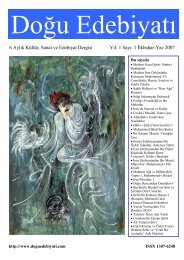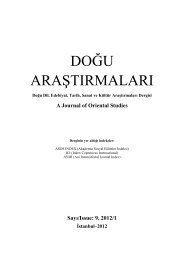A Journal of Oriental Studies Sayı/Issue - Doğu Edebiyatı
A Journal of Oriental Studies Sayı/Issue - Doğu Edebiyatı
A Journal of Oriental Studies Sayı/Issue - Doğu Edebiyatı
Create successful ePaper yourself
Turn your PDF publications into a flip-book with our unique Google optimized e-Paper software.
66<br />
THE SAFAVID AND NON SAFAVID…/MAHNAZ SARPISHEGI<br />
different sources; Most<strong>of</strong>i refers to 18 people 10 , Krowsinsky 159 11 , and<br />
Hazin 39 9 , <strong>of</strong> which the latter's seems closer to the reality as he was leaving<br />
in Isfahan at the time <strong>of</strong> these events. Mahmud was so much afraid <strong>of</strong> the<br />
Safavid king's escape so that he even murdered the three old uncles <strong>of</strong> the<br />
king" 12 .<br />
The Safavid Pretenders<br />
Some sources observe the claims <strong>of</strong> many pretenders and their relation to the<br />
Safavids (in some cases the individuals who claimed to be Safi Mirza or<br />
Esmail Mirza amounted to three people) as unfounded, and point that only<br />
the claims <strong>of</strong> Tahmasb the second and Seyyed AliMirza cannot be denied. 13<br />
Tahmasb Mirza. When Isfahan was under the siege <strong>of</strong> Mahmud's forces, the<br />
notable courtiers were considering the appointment <strong>of</strong> a crown prince for<br />
Shah Sultan Hussein. They had truly found out the importance <strong>of</strong> nominating<br />
a crown prince. The chiefs and the influential people would gather around him<br />
and would repel the intrigues. At first, Shah Sultan Hussein's elder son<br />
Mahmud Mirza and then Safi Mirza were chosen. Some sources refer to the<br />
latter as Bahram Mirza 14 . Later on the news <strong>of</strong> the flight <strong>of</strong> this prince ended<br />
in the murder <strong>of</strong> the other Safavid princes (perhaps the rise <strong>of</strong> some pretenders<br />
with the same name and the support <strong>of</strong> people is indicative <strong>of</strong> his not being in<br />
Isfahan at the time <strong>of</strong> murder). Safi Mirza left his <strong>of</strong>fice 15 days after the<br />
appointment and entered the harem. Eventually, Tahmasb Mirza was<br />
appointed and fled with some courtiers from Isfahan and became a symbol <strong>of</strong><br />
resistance against the Afghan dominance.<br />
Mirza Seyyed Ahmad. Son <strong>of</strong> Mirza Qassem and the grandson <strong>of</strong> Mirza<br />
Davud, the administrator <strong>of</strong> the holy shrine <strong>of</strong> Imam Reza at Meshed, he was<br />
related to the Safavids through his mother. Mirza Davud had married to<br />
Shahrbanu Beigum, the eldest daughter <strong>of</strong> Shah Suleiman and Mirza Qassem's<br />
sister (Seyyed Ahmad's aunt) was Shah Sultan Hussein's wife. 15 So from one<br />
side he was descended from Sheikh Safi-addin Ardebili, and from the other<br />
side from Mir Qavam-addin Marashi. This lineage was enough to have the<br />
support <strong>of</strong> the public. At the beginning he cooperated with Tahmasb Mirza,<br />
but when it turned up that the young Shah indulges in sensual pleasures, he<br />
parted with him went to Iraq and entered Abarqu and through the help <strong>of</strong> his<br />
1364)p. 266.<br />
10. Mohammad Mohsen Most<strong>of</strong>i, Zobdatol_Tavarikh, edited by Behruz Gudarzi( Tehran:<br />
Bonyade Moqufate Afshar, 1375)p. 170.<br />
11. Tadoziva Krosinsky, Safarnameh Krosinsky, translated by Abdolrazaq Donboli( Tehran:<br />
tus, 1363)p. 78.<br />
11. Hazin, ibid, p.207.<br />
12. De Sersoi, ibid. p. 267.<br />
13 . The Cambridge History <strong>of</strong> Iran, vol. 6. p.326.<br />
14. Alamaraye Naderi, vol. 1.p; 29.<br />
15. Hashem Mirza, Zabur al Davud, edited by AbdolHossein Navai( Tehran: Miras Maktub,<br />
1378)p; 82.





